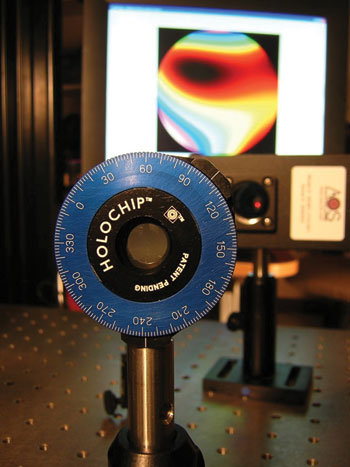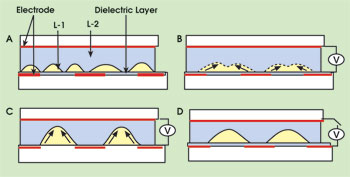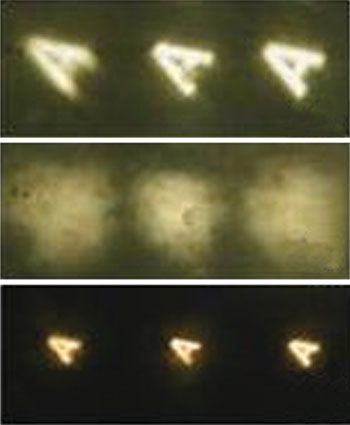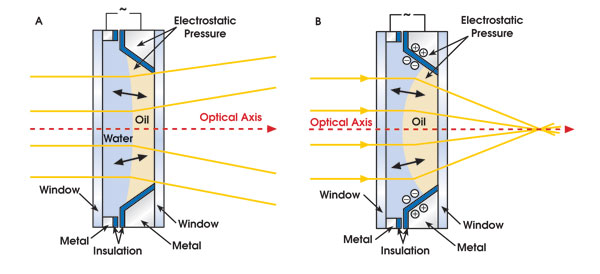Liquid lens technology is gaining steam for miniature optics applications.
Hank Hogan, Contributing Editor
If you want a variable lens in the future, you may have to get wet. That is the hope of several researchers and companies that are working on liquid lenses, devices that use water or another liquid as an optical element. These systems employ a variety of means to shape the liquid to adjust focal length, making it possible to tune a system’s optical performance very rapidly without mechanical movement.

This image was acquired using a liquid lens that changes focal length with applied voltage. Courtesy of Varioptic SA.
Liquid lenses are being put to use in cell phone and other small-form cameras as well as elsewhere. Herein is a review of how the technology works, its possible applications, and its benefits and drawbacks.
Not just in the eye of the beholder
Traditionally, varying focal length has been accomplished through the mechanical movement of static lenses. This approach, however, constrains the size, cost, reliability and speed of the system.
In contrast, liquid lenses vary their focal length by borrowing techniques from a familiar imaging system. “Fluidic lenses really are inspired by the human eye. They generally all go back to the same principle, and the idea has been around for a very long time,” said Robert Batchko, president and CEO of Holochip Corp. in Albuquerque, N.M.
The basic idea of his company’s liquid lenses, he explained, is that of a fluid confined by an elastic membrane. The application of hydrostatic pressure causes the membrane to bulge, changing from a flat surface to a curved one, for example. That transformation brings about an alteration in optical properties — including a shift in focal length — as the membrane transforms, for instance, from a flat to a concave surface. Varying the pressure adjusts the focal length, enabling the tuning of optical parameters. The resulting lenses are lighter, smaller, faster and more robust than those that use mechanical methods.

Turning the dial on the liquid lens system shown here changes the focal length of the lens. Courtesy of Holochip Corp.
Holochip develops and manufactures adaptive lenses based on its proprietary adaptive polymer lens technology, which has been in development for several years. The company now offers an adaptive singlet lens for optical research and engineering. The product can be mounted in standard optics hardware, such as posts and lens holders. The minimum focal length is 20 mm and the maximum is more than 1 m, giving a range of focal power greater than 50 diopters. Static lenses can be stacked in the housing to bias the focal length.
According to Batchko, the company’s adaptive lenses can be optimized for speed, diopter range, shock resistance or other parameters. The lenses use a proprietary fluid with what he characterized as excellent physical and optical qualities and are part of a blend of components, packaging and designs that are key to the devices’ success.
One problem that such lenses faced in the past was gravity, which could induce a position-dependent deviation from the ideal in the membrane shape. However, Batchko said that such effects had been addressed.
Various groups have investigated membrane-based liquid lenses. One such, at Louisiana Tech University in Ruston, placed a transparent flexible polymer, PDMS, atop a reservoir of the same material. Varying the pressure changed the shape of the membrane and, therefore, altered its optics. A similar approach was investigated by a team from the Institute of Materials Research and Engineering in Singapore.
Building many or just one
Holochip has licensed technology related to adaptive lenses from Louisiana Tech University and from the University of Central Florida in Orlando. Senior research scientist Hongwen Ren and optics professor Shin-Tson Wu, both of the latter institution have reported a demonstration, of a novel liquid lens technique that extends the idea into a microlens array.
As described in the Feb. 18, 2008, issue of Optics Express, the investigators’ method requires two nonconductive and immiscible liquids — one with a higher dielectric constant but a lower refractive index than the other. Both are colorless, nonpoisonous and of about equal density. The liquids are confined in a glass-walled chamber, which has an electrode with an array of holes patterned onto a substrate.
When a voltage is applied, the two liquids migrate in response to the different dielectric force each experiences. The liquid with the low dielectric constant moves to the weak electric field region, while the other congregates in the strong electric field region. After the liquids separate, they remain in place, with the shape of the liquid drops controlled by the applied voltage.

This schematic shows how some researchers form an array of microlenses with liquids. Nonmixing liquids L-1 and L-2 sit atop an electrode with holes in it (A). A droplet forms atop the holes (B) and, when a voltage is applied, the droplets change shape (C), remaining in a relaxed state without voltage (D). Reprinted with permission from Optics Express.
“Using this approach, the liquid-droplet array can be formed electrically. Once the formed droplet array is stabilized, each droplet functions as a microlens,” Wu said.
In a demonstration, Ren and Wu used an opaque aluminum electrode with 140-μm-diameter holes spaced 100 μm apart in a cell with a gap of about 120 μm. They filled the cell with deionized water and the diacrylate monomer AE-93. The density of the two fluids did not match well. However, Ren explained that the adhesive force of the droplet on the substrate surface was far greater than the force of gravity. Therefore, the influence of gravity on the monomer droplet shape was negligible, and the technique worked.
Tests performed with an Olympus microscope showed that the response time of the liquid lens microarray was 30 ms for the rise and about 250 ms for the fall. Other tests showed that the focal length varied from 2.1 to 1.4 mm as the voltage varied from 0 to 88 V. Changing the cell gap and other parameters would increase that dynamic range. Besides building a microliquid lens array, the technique also could be used to build a single lens suitable for a cell phone camera or for other uses.
Although it worked, the prototype demanded too high a voltage for practical applications. The voltage required was an inverse function of the difference in the dielectric constant of the two liquids. A larger difference would mean that a lower voltage would be needed to shape the droplets. Likewise, an electrode layout that increased the voltage gradient would decrease the required voltage. Therefore, the next step in the research, Wu said, would be to choose suitable liquids so that the operating voltage and the lens aberrations would be decreased at the same time.
Charged up
Another electrically driven adaptive liquid lens comes from Varioptic SA of Lyon, France. Developed by Bruno Berge, who founded the company in 2002, the liquid lens technology is based on electrowetting. The device consists of a water drop deposited onto a metal substrate covered by a thin insulating layer of another liquid that also sits atop a transparent window. The two liquids do not mix and are of the same density. One is a conductor and the other, an insulator.
Applying a voltage across the cell gap changes the contact angle of the conducting drop, altering the curvature of the liquid-liquid interface. The result is a change in the focal length of the lens, which can vary from infinity to as little as a few centimeters. Unlike some other approaches, these liquid lenses are largely immune to gravity.

Shown are imaging properties of the University of Central Florida’s microlens array at 0 V (top), 60 V (center) and at a refocused state (bottom). Reprinted with permission from Optics Express.
The company’s autofocus liquid lenses are gaining commercial acceptance and are being produced in large quantities by Varioptic and its production partners, Creative Sensor of Taiwan and Seiko Instruments of Japan. Production capacity is forecast to grow from half a million units this year to 72 million by 2010. According to Varioptic’s vice president of marketing, John Barber, the lenses are suitable for cameras in mobile phones.
As with their stand-alone consumer counterparts, such cameras are climbing in the number of megapixels offered, with ≥5-megapixel camera phones now rolling out. Besides autofocus in cell phones, other uses for Varioptic’s products involve industrial cameras and even 2-D barcode readers, Barber said. The latter image the small block of marks increasingly used to identify machine parts and other components. With a static lens, various designs are needed for long- and short-range systems. With a liquid lens, a single design can meet both needs.
Lenses that use electrowetting processes require high voltage, at least in terms of what usually is found in the semiconductor world. To help address this, Varioptic has teamed up with Supertex Inc. of Sunnyvale, Calif., which will provide the integrated circuits needed to drive the lenses, with chips capable of producing up to 60 V rms.
No moving parts
One issue with an electrowetting-based liquid lens is the nature of the liquids involved. One must be a conductor, and the difference in the index of refraction between the two liquids must be high. These attributes make the scheme work and improve the range over which the focus can be adjusted.
However, they also can have implications for the optical performance of the lens because such a pair of liquids can be highly dispersive, making the lens itself highly dispersive and leading to greater chromatic aberration.
This effect is not a problem for autofocus systems built using Varioptic’s current liquid lens technology because the required change in optical power is much less than what is needed for a zoom system. Thus, liquids with a lower refractive index and lower resulting chromatic aberration can be used.
Frank C. Wippermann, a scientist at Fraunhofer Institute for Applied Optics and Precision Engineering in Jena, Germany, was part of a group that looked at how to use electrowetting technology in a miniaturized zoom lens. The goal of the research, which was done in collaboration with Varioptic, was to create a system with a 3× zoom in a form factor suitable for a cell phone camera.

In an electrowetting lens, the interface between two liquids is the variable optical element. When the voltage is off, the lens has one focal length (A); when a voltage is applied, the focal length changes (B). These lenses are used in autofocus systems for some small-form cameras. Courtesy of Varioptic.
To contend with chromatic aberration, the group devised a couple of solutions but did not build a prototype before the project ended. One involved two liquid lenses, with a mechanical actuator moving one lens relative to another. The second also involved two liquid lenses, with a sequential acquisition of red, green and blue images.
Wippermann said that the institute’s researchers now are using adaptive lenses for ultraflat imaging. They take advantage of the fact that a liquid lens has no moving parts, combining it with an imager modeled after the monochrome compound eye of an insect.
“We took one liquid lens and put it in front of the compound eye. Then you have a very nice zoom lens with only one adaptive liquid lens,” Wippermann said.
As for other applications for liquid lenses, Benno H.W. Hendriks — a researcher involved with the FluidFocus electrowetting technology developed by Philips Research in Eindhoven, the Netherlands — offered some thoughts on what they might be. Philips has yet to produce any products with the technology and will not discuss any specific future product plans, but Hendriks said that any parts that incorporate a liquid lens would have some characteristics in common, a prescription for the areas where this new technology might be expected to make a splash.
“Typical products could be products which have optical modules that need no moving parts, a small form factor, low power consumption, fast focus speed and robustness,” he said.